Evidence-Based Practice: Assessment and Care Planning Report
VerifiedAdded on 2022/12/01
|7
|1814
|436
Report
AI Summary
This report provides an evidence-based practice (EBP) analysis of a case study involving an 84-year-old gentleman, Mr. Orkin, who experienced a collapse and presents with multiple health concerns. The report begins with an introduction identifying the patient's health issues and concerns, primarily focusing on the potential side effects of his medications (Diamicron, Amlodipine, and Simvastatin) and their impact on his health. The report outlines the process of conducting primary, secondary, and focused assessments, detailing the five steps involved: scene size-up, primary assessment, medical history, secondary assessment, and reassessment. It emphasizes the importance of assessing vital signs and adapting interventions based on patient status. The report also provides recommendations for nursing interventions, suggesting alternative medications with fewer side effects, such as gliclazide or Metformin instead of Diamicron, Felodipine or Tartrate instead of Amlodipine, and pitavastatin or lovastatin instead of Simvastatin. The overall aim is to promote patient well-being through evidence-based practices and appropriate medication management.
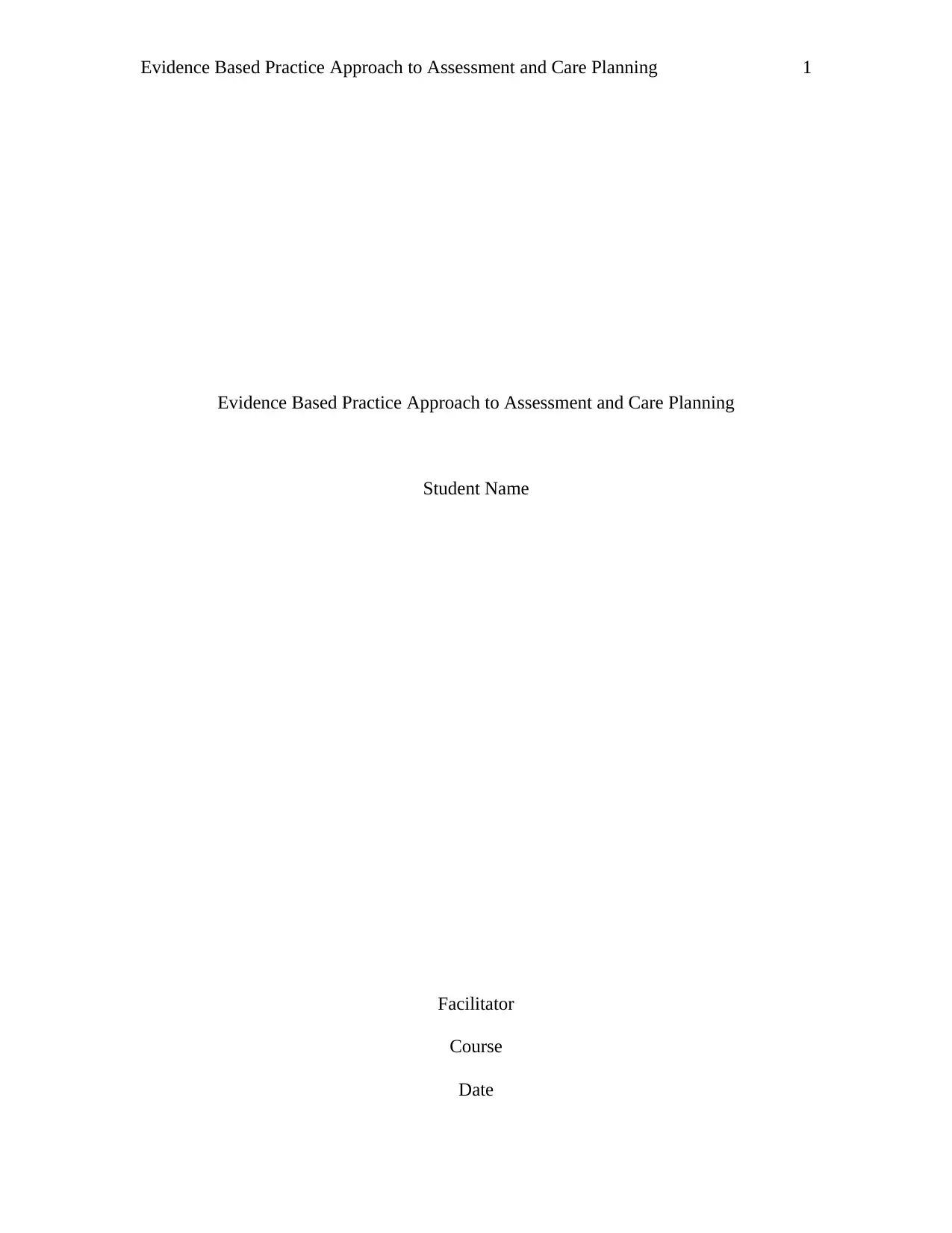
Evidence Based Practice Approach to Assessment and Care Planning 1
Evidence Based Practice Approach to Assessment and Care Planning
Student Name
Facilitator
Course
Date
Evidence Based Practice Approach to Assessment and Care Planning
Student Name
Facilitator
Course
Date
Paraphrase This Document
Need a fresh take? Get an instant paraphrase of this document with our AI Paraphraser

Evidence Based Practice Approach to Assessment and Care Planning 2
Introduction
From the health assessment of Mr. Orkin, an 84-year-old gentleman admitted
following his collapse at home which followed five steps: performing a scene size up,
primary assessment, obtaining the patients’ medical history, performing the secondary
assessment and then a reassessment, there are several health issues and concerns which
can be identified.
The Issues and Concerns Identified
The main concern is on the possible side effects of the drugs taken by Mr. Orkin.
As mentioned in the case study, to control his health status he has been taking Diamicron
80 milligrams twice daily, Amlodipine 5 milligrams in the morning and Simvastatin 20
milligram in the evening whose side effects seem to be the root cause of his health
conditions. Based on the assessment of the side effects associated with the three drugs
taken by Mr. Orkin on daily basis and his signs and symptoms from the assessments,
there is a likelihood that his condition is as a result of medication side effects. For
instance, experts have warned doctors against Amlodipine which is believed to act as a
catalyst on hypotension patients whose symptoms include tiredness, nauseous and
fainting as observed in the case of Mr. Orkin.
Dizziness and confusion symptoms which eventually cause fainting have been
listed among the side effects of the two drugs Mr. Orkin is taking (Amlodipine &
Diamicron). In addition to the side effects of Amlodipine, the intense of fainting
experienced by Mr. Orkin has increased making him unconscious.
Analyzing the health condition fluctuations of Mr. Orkin, the concern on the side
effects of his medication gets support. For instance, his wife did not narrate of a
Introduction
From the health assessment of Mr. Orkin, an 84-year-old gentleman admitted
following his collapse at home which followed five steps: performing a scene size up,
primary assessment, obtaining the patients’ medical history, performing the secondary
assessment and then a reassessment, there are several health issues and concerns which
can be identified.
The Issues and Concerns Identified
The main concern is on the possible side effects of the drugs taken by Mr. Orkin.
As mentioned in the case study, to control his health status he has been taking Diamicron
80 milligrams twice daily, Amlodipine 5 milligrams in the morning and Simvastatin 20
milligram in the evening whose side effects seem to be the root cause of his health
conditions. Based on the assessment of the side effects associated with the three drugs
taken by Mr. Orkin on daily basis and his signs and symptoms from the assessments,
there is a likelihood that his condition is as a result of medication side effects. For
instance, experts have warned doctors against Amlodipine which is believed to act as a
catalyst on hypotension patients whose symptoms include tiredness, nauseous and
fainting as observed in the case of Mr. Orkin.
Dizziness and confusion symptoms which eventually cause fainting have been
listed among the side effects of the two drugs Mr. Orkin is taking (Amlodipine &
Diamicron). In addition to the side effects of Amlodipine, the intense of fainting
experienced by Mr. Orkin has increased making him unconscious.
Analyzing the health condition fluctuations of Mr. Orkin, the concern on the side
effects of his medication gets support. For instance, his wife did not narrate of a
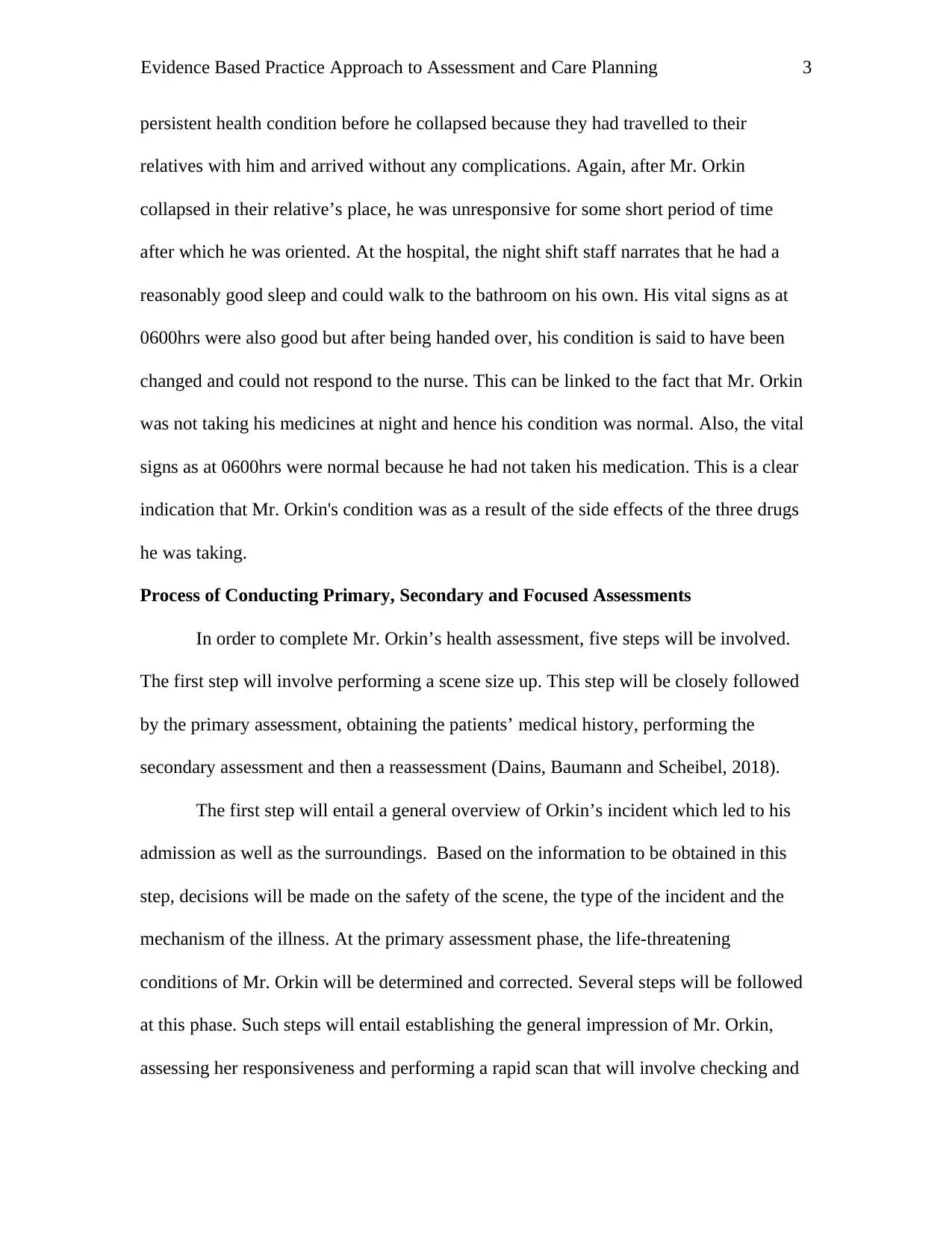
Evidence Based Practice Approach to Assessment and Care Planning 3
persistent health condition before he collapsed because they had travelled to their
relatives with him and arrived without any complications. Again, after Mr. Orkin
collapsed in their relative’s place, he was unresponsive for some short period of time
after which he was oriented. At the hospital, the night shift staff narrates that he had a
reasonably good sleep and could walk to the bathroom on his own. His vital signs as at
0600hrs were also good but after being handed over, his condition is said to have been
changed and could not respond to the nurse. This can be linked to the fact that Mr. Orkin
was not taking his medicines at night and hence his condition was normal. Also, the vital
signs as at 0600hrs were normal because he had not taken his medication. This is a clear
indication that Mr. Orkin's condition was as a result of the side effects of the three drugs
he was taking.
Process of Conducting Primary, Secondary and Focused Assessments
In order to complete Mr. Orkin’s health assessment, five steps will be involved.
The first step will involve performing a scene size up. This step will be closely followed
by the primary assessment, obtaining the patients’ medical history, performing the
secondary assessment and then a reassessment (Dains, Baumann and Scheibel, 2018).
The first step will entail a general overview of Orkin’s incident which led to his
admission as well as the surroundings. Based on the information to be obtained in this
step, decisions will be made on the safety of the scene, the type of the incident and the
mechanism of the illness. At the primary assessment phase, the life-threatening
conditions of Mr. Orkin will be determined and corrected. Several steps will be followed
at this phase. Such steps will entail establishing the general impression of Mr. Orkin,
assessing her responsiveness and performing a rapid scan that will involve checking and
persistent health condition before he collapsed because they had travelled to their
relatives with him and arrived without any complications. Again, after Mr. Orkin
collapsed in their relative’s place, he was unresponsive for some short period of time
after which he was oriented. At the hospital, the night shift staff narrates that he had a
reasonably good sleep and could walk to the bathroom on his own. His vital signs as at
0600hrs were also good but after being handed over, his condition is said to have been
changed and could not respond to the nurse. This can be linked to the fact that Mr. Orkin
was not taking his medicines at night and hence his condition was normal. Also, the vital
signs as at 0600hrs were normal because he had not taken his medication. This is a clear
indication that Mr. Orkin's condition was as a result of the side effects of the three drugs
he was taking.
Process of Conducting Primary, Secondary and Focused Assessments
In order to complete Mr. Orkin’s health assessment, five steps will be involved.
The first step will involve performing a scene size up. This step will be closely followed
by the primary assessment, obtaining the patients’ medical history, performing the
secondary assessment and then a reassessment (Dains, Baumann and Scheibel, 2018).
The first step will entail a general overview of Orkin’s incident which led to his
admission as well as the surroundings. Based on the information to be obtained in this
step, decisions will be made on the safety of the scene, the type of the incident and the
mechanism of the illness. At the primary assessment phase, the life-threatening
conditions of Mr. Orkin will be determined and corrected. Several steps will be followed
at this phase. Such steps will entail establishing the general impression of Mr. Orkin,
assessing her responsiveness and performing a rapid scan that will involve checking and
⊘ This is a preview!⊘
Do you want full access?
Subscribe today to unlock all pages.

Trusted by 1+ million students worldwide

Evidence Based Practice Approach to Assessment and Care Planning 4
correcting the problems with his airways, respiratory system and air circulation in general
(Johnston et al, 2019, p.11). The assessment will then close by updating the responding
EMS units.
The main reason behind the medical history analysis will be to help put together
the systematic account of Mr. Orkin’s past medical conditions and general health status in
order to determine the signs and symptoms of his current condition. Also, the sample
history of his health conditions will provide a framework to guide when asking him
questions (Bansler et al, 2016, p.520).
After the primary assessment, the secondary assessment will be done. It will
consist of a full-body assessment of Mr. Orkin with the aim of assessing other non-
threatening or secondary conditions he might be facing. It will be done after stabilizing
any possible life-threatening condition in the primary assessment phase. With this
assessment, any signs and symptoms of illness will be located and managed. After the
full-body assessment, Mr. Orkin’s vital signs will be assessed (Geraets et al, 2015,
p.970). Essentially, Mr. Orkin will be watched carefully for any changes in his status.
Even if he is stable, the assessment of the vital signs will be repeated after every 15
minutes. In case his health conditions changes, primary assessment will be repeated to
identify the root cause of such changes. A concise and accurate hand-off report to the
EMS personnel will be produced. Ongoing support will be provided until the patient
recovers (Adriaansen et al, 2016, p.855).
Nursing Interventions Appropriate
The main issue identified in the case of Mr. Orkin in the first part is the fact that
he is taking medications which have started to have side effects on her general health.
correcting the problems with his airways, respiratory system and air circulation in general
(Johnston et al, 2019, p.11). The assessment will then close by updating the responding
EMS units.
The main reason behind the medical history analysis will be to help put together
the systematic account of Mr. Orkin’s past medical conditions and general health status in
order to determine the signs and symptoms of his current condition. Also, the sample
history of his health conditions will provide a framework to guide when asking him
questions (Bansler et al, 2016, p.520).
After the primary assessment, the secondary assessment will be done. It will
consist of a full-body assessment of Mr. Orkin with the aim of assessing other non-
threatening or secondary conditions he might be facing. It will be done after stabilizing
any possible life-threatening condition in the primary assessment phase. With this
assessment, any signs and symptoms of illness will be located and managed. After the
full-body assessment, Mr. Orkin’s vital signs will be assessed (Geraets et al, 2015,
p.970). Essentially, Mr. Orkin will be watched carefully for any changes in his status.
Even if he is stable, the assessment of the vital signs will be repeated after every 15
minutes. In case his health conditions changes, primary assessment will be repeated to
identify the root cause of such changes. A concise and accurate hand-off report to the
EMS personnel will be produced. Ongoing support will be provided until the patient
recovers (Adriaansen et al, 2016, p.855).
Nursing Interventions Appropriate
The main issue identified in the case of Mr. Orkin in the first part is the fact that
he is taking medications which have started to have side effects on her general health.
Paraphrase This Document
Need a fresh take? Get an instant paraphrase of this document with our AI Paraphraser
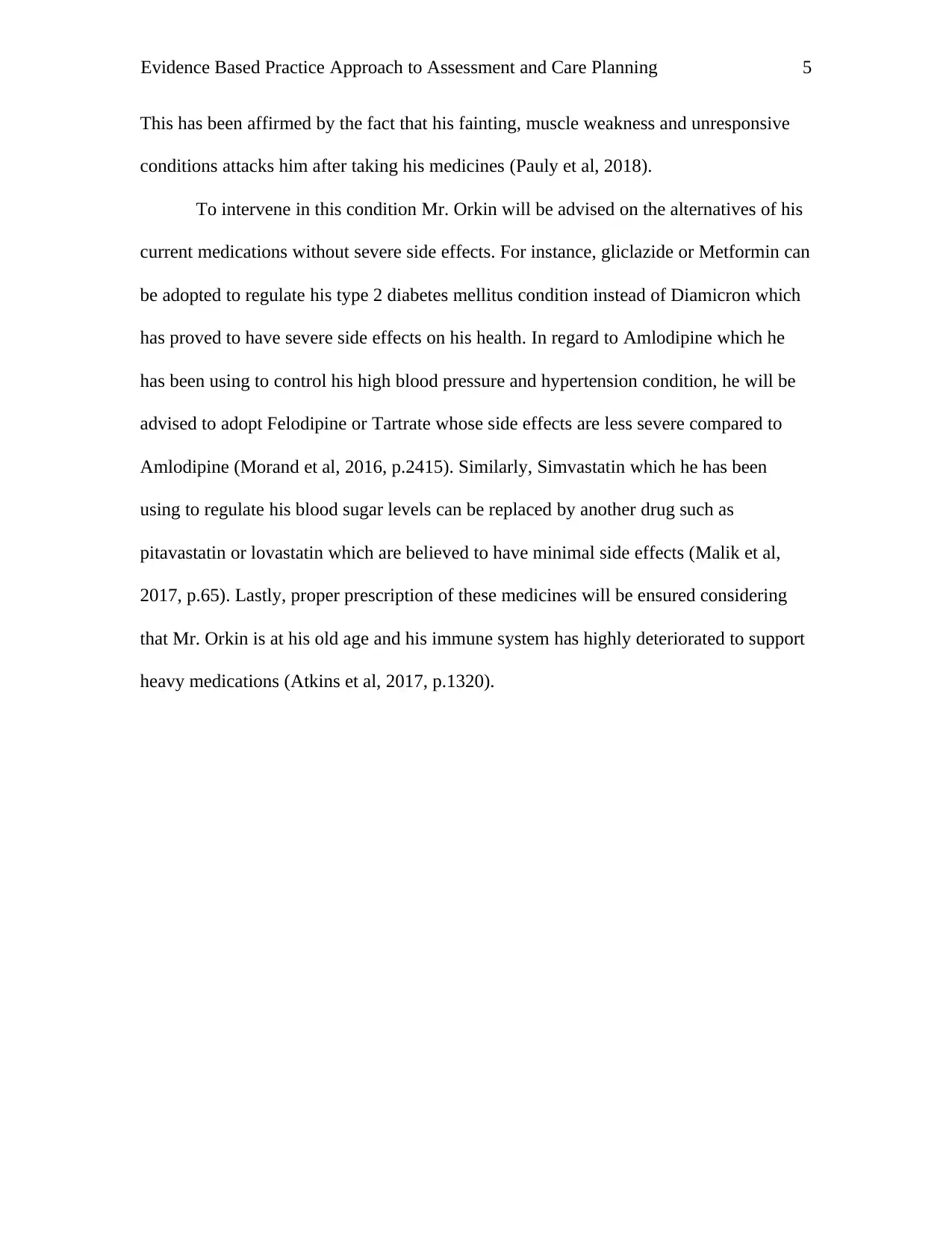
Evidence Based Practice Approach to Assessment and Care Planning 5
This has been affirmed by the fact that his fainting, muscle weakness and unresponsive
conditions attacks him after taking his medicines (Pauly et al, 2018).
To intervene in this condition Mr. Orkin will be advised on the alternatives of his
current medications without severe side effects. For instance, gliclazide or Metformin can
be adopted to regulate his type 2 diabetes mellitus condition instead of Diamicron which
has proved to have severe side effects on his health. In regard to Amlodipine which he
has been using to control his high blood pressure and hypertension condition, he will be
advised to adopt Felodipine or Tartrate whose side effects are less severe compared to
Amlodipine (Morand et al, 2016, p.2415). Similarly, Simvastatin which he has been
using to regulate his blood sugar levels can be replaced by another drug such as
pitavastatin or lovastatin which are believed to have minimal side effects (Malik et al,
2017, p.65). Lastly, proper prescription of these medicines will be ensured considering
that Mr. Orkin is at his old age and his immune system has highly deteriorated to support
heavy medications (Atkins et al, 2017, p.1320).
This has been affirmed by the fact that his fainting, muscle weakness and unresponsive
conditions attacks him after taking his medicines (Pauly et al, 2018).
To intervene in this condition Mr. Orkin will be advised on the alternatives of his
current medications without severe side effects. For instance, gliclazide or Metformin can
be adopted to regulate his type 2 diabetes mellitus condition instead of Diamicron which
has proved to have severe side effects on his health. In regard to Amlodipine which he
has been using to control his high blood pressure and hypertension condition, he will be
advised to adopt Felodipine or Tartrate whose side effects are less severe compared to
Amlodipine (Morand et al, 2016, p.2415). Similarly, Simvastatin which he has been
using to regulate his blood sugar levels can be replaced by another drug such as
pitavastatin or lovastatin which are believed to have minimal side effects (Malik et al,
2017, p.65). Lastly, proper prescription of these medicines will be ensured considering
that Mr. Orkin is at his old age and his immune system has highly deteriorated to support
heavy medications (Atkins et al, 2017, p.1320).
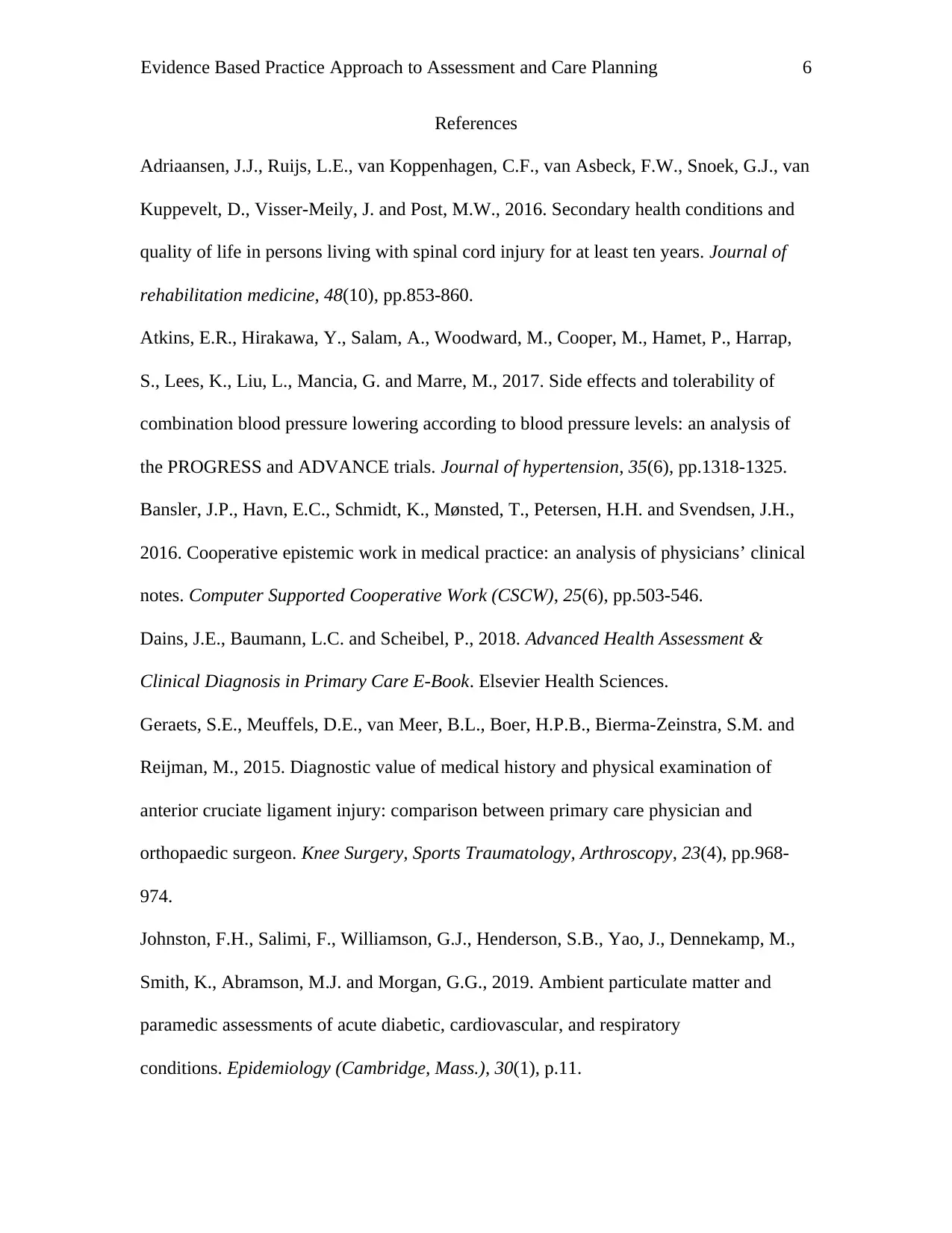
Evidence Based Practice Approach to Assessment and Care Planning 6
References
Adriaansen, J.J., Ruijs, L.E., van Koppenhagen, C.F., van Asbeck, F.W., Snoek, G.J., van
Kuppevelt, D., Visser-Meily, J. and Post, M.W., 2016. Secondary health conditions and
quality of life in persons living with spinal cord injury for at least ten years. Journal of
rehabilitation medicine, 48(10), pp.853-860.
Atkins, E.R., Hirakawa, Y., Salam, A., Woodward, M., Cooper, M., Hamet, P., Harrap,
S., Lees, K., Liu, L., Mancia, G. and Marre, M., 2017. Side effects and tolerability of
combination blood pressure lowering according to blood pressure levels: an analysis of
the PROGRESS and ADVANCE trials. Journal of hypertension, 35(6), pp.1318-1325.
Bansler, J.P., Havn, E.C., Schmidt, K., Mønsted, T., Petersen, H.H. and Svendsen, J.H.,
2016. Cooperative epistemic work in medical practice: an analysis of physicians’ clinical
notes. Computer Supported Cooperative Work (CSCW), 25(6), pp.503-546.
Dains, J.E., Baumann, L.C. and Scheibel, P., 2018. Advanced Health Assessment &
Clinical Diagnosis in Primary Care E-Book. Elsevier Health Sciences.
Geraets, S.E., Meuffels, D.E., van Meer, B.L., Boer, H.P.B., Bierma-Zeinstra, S.M. and
Reijman, M., 2015. Diagnostic value of medical history and physical examination of
anterior cruciate ligament injury: comparison between primary care physician and
orthopaedic surgeon. Knee Surgery, Sports Traumatology, Arthroscopy, 23(4), pp.968-
974.
Johnston, F.H., Salimi, F., Williamson, G.J., Henderson, S.B., Yao, J., Dennekamp, M.,
Smith, K., Abramson, M.J. and Morgan, G.G., 2019. Ambient particulate matter and
paramedic assessments of acute diabetic, cardiovascular, and respiratory
conditions. Epidemiology (Cambridge, Mass.), 30(1), p.11.
References
Adriaansen, J.J., Ruijs, L.E., van Koppenhagen, C.F., van Asbeck, F.W., Snoek, G.J., van
Kuppevelt, D., Visser-Meily, J. and Post, M.W., 2016. Secondary health conditions and
quality of life in persons living with spinal cord injury for at least ten years. Journal of
rehabilitation medicine, 48(10), pp.853-860.
Atkins, E.R., Hirakawa, Y., Salam, A., Woodward, M., Cooper, M., Hamet, P., Harrap,
S., Lees, K., Liu, L., Mancia, G. and Marre, M., 2017. Side effects and tolerability of
combination blood pressure lowering according to blood pressure levels: an analysis of
the PROGRESS and ADVANCE trials. Journal of hypertension, 35(6), pp.1318-1325.
Bansler, J.P., Havn, E.C., Schmidt, K., Mønsted, T., Petersen, H.H. and Svendsen, J.H.,
2016. Cooperative epistemic work in medical practice: an analysis of physicians’ clinical
notes. Computer Supported Cooperative Work (CSCW), 25(6), pp.503-546.
Dains, J.E., Baumann, L.C. and Scheibel, P., 2018. Advanced Health Assessment &
Clinical Diagnosis in Primary Care E-Book. Elsevier Health Sciences.
Geraets, S.E., Meuffels, D.E., van Meer, B.L., Boer, H.P.B., Bierma-Zeinstra, S.M. and
Reijman, M., 2015. Diagnostic value of medical history and physical examination of
anterior cruciate ligament injury: comparison between primary care physician and
orthopaedic surgeon. Knee Surgery, Sports Traumatology, Arthroscopy, 23(4), pp.968-
974.
Johnston, F.H., Salimi, F., Williamson, G.J., Henderson, S.B., Yao, J., Dennekamp, M.,
Smith, K., Abramson, M.J. and Morgan, G.G., 2019. Ambient particulate matter and
paramedic assessments of acute diabetic, cardiovascular, and respiratory
conditions. Epidemiology (Cambridge, Mass.), 30(1), p.11.
⊘ This is a preview!⊘
Do you want full access?
Subscribe today to unlock all pages.

Trusted by 1+ million students worldwide
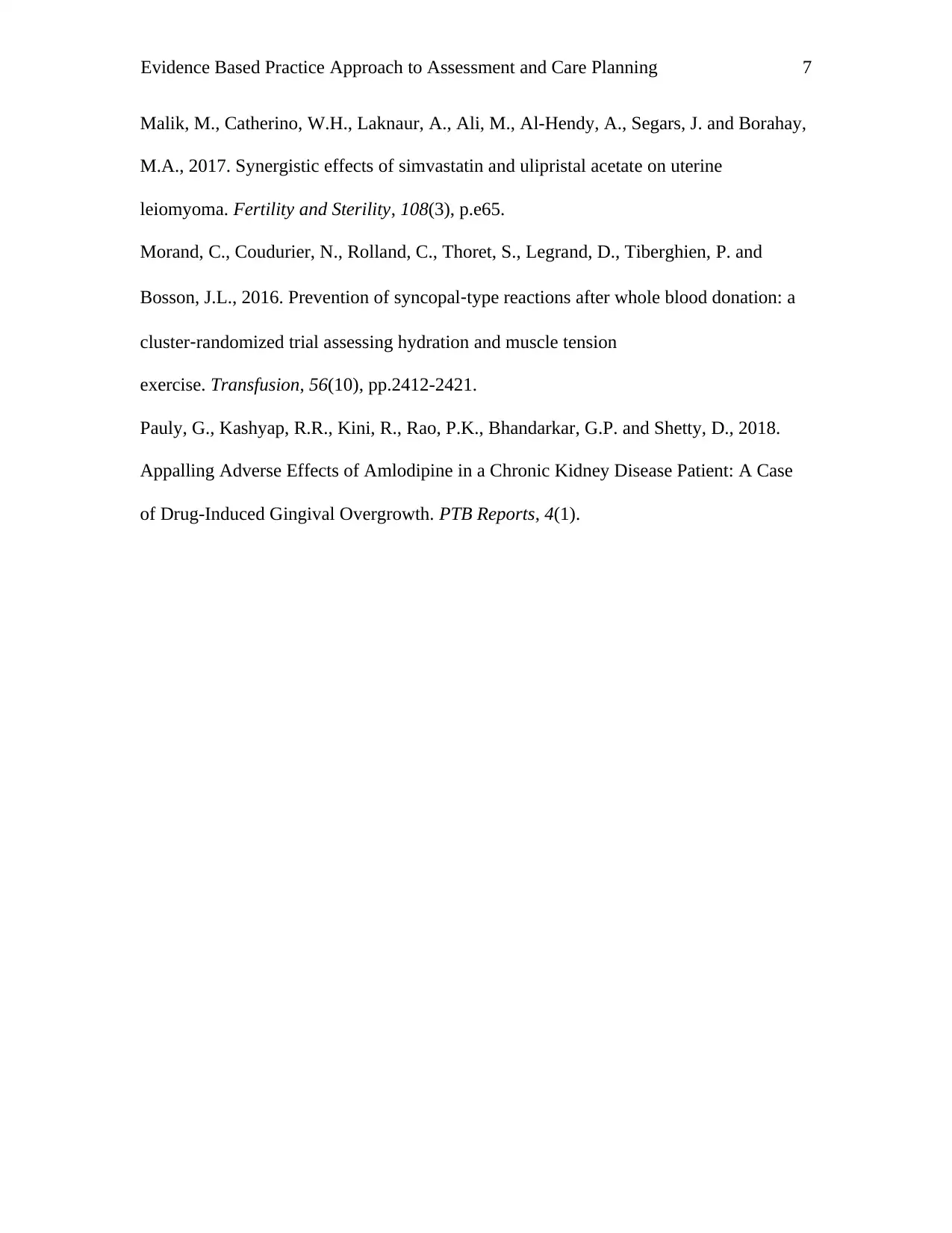
Evidence Based Practice Approach to Assessment and Care Planning 7
Malik, M., Catherino, W.H., Laknaur, A., Ali, M., Al-Hendy, A., Segars, J. and Borahay,
M.A., 2017. Synergistic effects of simvastatin and ulipristal acetate on uterine
leiomyoma. Fertility and Sterility, 108(3), p.e65.
Morand, C., Coudurier, N., Rolland, C., Thoret, S., Legrand, D., Tiberghien, P. and
Bosson, J.L., 2016. Prevention of syncopal‐type reactions after whole blood donation: a
cluster‐randomized trial assessing hydration and muscle tension
exercise. Transfusion, 56(10), pp.2412-2421.
Pauly, G., Kashyap, R.R., Kini, R., Rao, P.K., Bhandarkar, G.P. and Shetty, D., 2018.
Appalling Adverse Effects of Amlodipine in a Chronic Kidney Disease Patient: A Case
of Drug-Induced Gingival Overgrowth. PTB Reports, 4(1).
Malik, M., Catherino, W.H., Laknaur, A., Ali, M., Al-Hendy, A., Segars, J. and Borahay,
M.A., 2017. Synergistic effects of simvastatin and ulipristal acetate on uterine
leiomyoma. Fertility and Sterility, 108(3), p.e65.
Morand, C., Coudurier, N., Rolland, C., Thoret, S., Legrand, D., Tiberghien, P. and
Bosson, J.L., 2016. Prevention of syncopal‐type reactions after whole blood donation: a
cluster‐randomized trial assessing hydration and muscle tension
exercise. Transfusion, 56(10), pp.2412-2421.
Pauly, G., Kashyap, R.R., Kini, R., Rao, P.K., Bhandarkar, G.P. and Shetty, D., 2018.
Appalling Adverse Effects of Amlodipine in a Chronic Kidney Disease Patient: A Case
of Drug-Induced Gingival Overgrowth. PTB Reports, 4(1).
1 out of 7
Related Documents
Your All-in-One AI-Powered Toolkit for Academic Success.
+13062052269
info@desklib.com
Available 24*7 on WhatsApp / Email
![[object Object]](/_next/static/media/star-bottom.7253800d.svg)
Unlock your academic potential
Copyright © 2020–2025 A2Z Services. All Rights Reserved. Developed and managed by ZUCOL.





